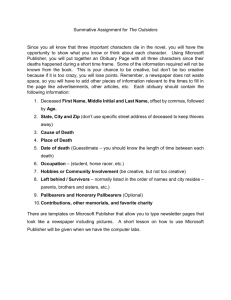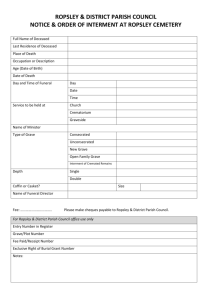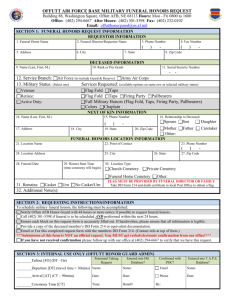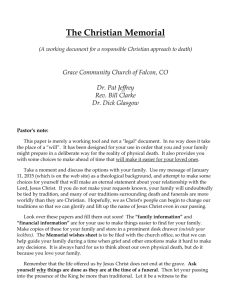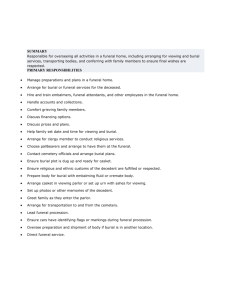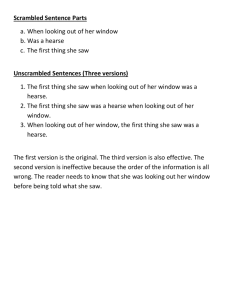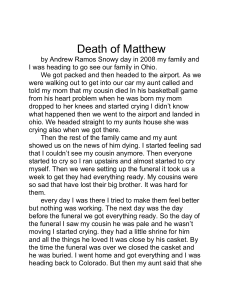Section VIII - The Citadel
advertisement
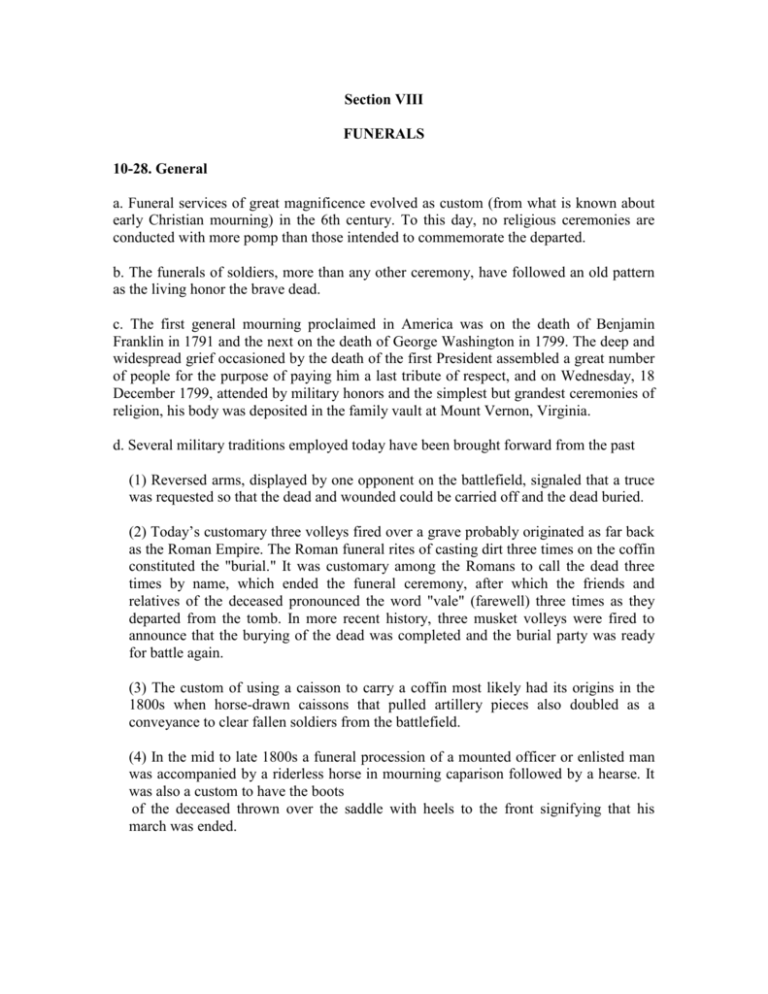
Section VIII FUNERALS 10-28. General a. Funeral services of great magnificence evolved as custom (from what is known about early Christian mourning) in the 6th century. To this day, no religious ceremonies are conducted with more pomp than those intended to commemorate the departed. b. The funerals of soldiers, more than any other ceremony, have followed an old pattern as the living honor the brave dead. c. The first general mourning proclaimed in America was on the death of Benjamin Franklin in 1791 and the next on the death of George Washington in 1799. The deep and widespread grief occasioned by the death of the first President assembled a great number of people for the purpose of paying him a last tribute of respect, and on Wednesday, 18 December 1799, attended by military honors and the simplest but grandest ceremonies of religion, his body was deposited in the family vault at Mount Vernon, Virginia. d. Several military traditions employed today have been brought forward from the past (1) Reversed arms, displayed by one opponent on the battlefield, signaled that a truce was requested so that the dead and wounded could be carried off and the dead buried. (2) Today’s customary three volleys fired over a grave probably originated as far back as the Roman Empire. The Roman funeral rites of casting dirt three times on the coffin constituted the "burial." It was customary among the Romans to call the dead three times by name, which ended the funeral ceremony, after which the friends and relatives of the deceased pronounced the word "vale" (farewell) three times as they departed from the tomb. In more recent history, three musket volleys were fired to announce that the burying of the dead was completed and the burial party was ready for battle again. (3) The custom of using a caisson to carry a coffin most likely had its origins in the 1800s when horse-drawn caissons that pulled artillery pieces also doubled as a conveyance to clear fallen soldiers from the battlefield. (4) In the mid to late 1800s a funeral procession of a mounted officer or enlisted man was accompanied by a riderless horse in mourning caparison followed by a hearse. It was also a custom to have the boots of the deceased thrown over the saddle with heels to the front signifying that his march was ended. 10-29. Types of Funerals a. Military funerals are divided into the two following classes: (1) Chapel service, followed by movement to the grave or place of local disposition with the prescribed escort. (2) With graveside service only. b. A full military funeral normally consists of the following elements: (1) Band. (2) Escort appropriate to the grade of the deceased, including a firing party and bugler (AR 600-25). (3) Colors. (4) Clergy. (5) Hearse (caisson) and active pallbearers. (6) Honorary pallbearers. (7) Personal color (if appropriate). c. Upon request, chaplains conduct or arrange for appropriate burial services for interment of members of the military service, active and retired, and for members of their families. The family of the deceased (or its representative) may, however, request some other clergyman to officiate in lieu of a military chaplain. A civilian clergyman can conduct all religious elements of a military funeral or interment. The desires of the family are given the fullest consideration possible in the selection of elements involved, but the funeral is conducted as prescribed in this manual. d. The president of the college or his representative, in coordination with the cemetery superintendent and the funeral director, makes the funeral arrangements and supervises the conduct of the funeral. e. When honorary pallbearers are desired, they are selected by the family of the deceased or its representative, or when the family or its representative so desires, by the college president. As a rule, no more than twelve honorary pallbearers should be selected. f. At a military funeral, persons in military and cadet uniform attending in their individual capacity face the casket and execute the hand salute at the following times: when honors, if any, are sounded; at any time when the casket is being moved (the exception being when they themselves are moving); during cannon salutes, if sounded; during the firing of volleys; and while "Taps" is being played. (1) Honorary pallbearers in uniform conform to those instructions when not in motion. (2) Military and cadet personnel in civilian clothes in the above cases, and during the service at the grave, stand at attention, uncover, and hold the headdress over the left shoulder with the right hand over the heart. If no headdress is worn, the right hand is held over the heart. (3) Female military and cadet personnel in civilian clothes hold the right hand over the heart. g. During the religious graveside service, all personnel bow their heads at the words "Let us pray." All mourners at graveside except the active pallbearers follow the example of the officiating chaplain. If he uncovers, they uncover; if he remains covered, they remain covered. When the officiating chaplain wears a biretta (clerical headpiece) during the graveside service, all personnel, as indicated above, uncover. When the officiating chaplain wears a yarmulke (Jewish skull cap), all personnel remain covered. h. The remains of a member of the armed forces, who died while on active duty, may be consigned directly to a national cemetery from a military installation. In such cases, the cemetery superintendent will, regardless of time of arrival, if not otherwise provided for, engage a funeral director to receive the remains at the common carrier terminal, hold the remains at his establishment until the date of the funeral, if necessary, and deliver the remains to the cemetery. The superintendent will not authorize a funeral director to render any other service incident to the interment. i. The word chapel is interpreted to include the church, home, or other place where services are held, other than the service at the grave. j. The word casket is interpreted to include a receptacle containing the cremated remains of the deceased. 10-30. Funeral with Chapel Service a. Before the beginning of the service, the funeral escort is formed in line facing the chapel. The band forms on the flank toward which it is to march. b. Members of the immediate family, relatives, and friends of the deceased are requested to enter the chapel and be seated before the casket is taken in. Members of the immediate family and relatives occupy pews (seats) to the right (front) of the chapel. c. The hearse bearing the remains to the chapel should arrive in front of the chapel a few moments before the time set for the service. As the hearse approaches, the escort commander commands Escort, ATTENTION and he salutes until the hearse stops in front of the chapel. When all is in readiness to move the casket into the chapel, the commander of the escort brings the escort to Present, ARMS. As the escort commander presents arms, the band renders the honors prescribed in AR 600-25, if appropriate, followed by a hymn. At the first note of the hymn, the casket is moved from the hearse by the active pallbearers and carried between the ranks of honorary pallbearers, if any, into the chapel. The remains are handled in a dignified, reverent, and military manner, ensuring that the casket is carried level and feet first at all times. As soon as the casket enters the chapel, the band ceases to play, and the escort commander brings the escort to Order, ARMS and AT EAST. d. When honorary pallbearers are present, they are formed in two ranks, each facing the other, in order of seniority, most senior closest to the hearse, thus forming an aisle from the hearse to the entrance of the chapel. At the first note of the music, and while the casket is being borne between the ranks of honorary pallbearers, they uncover or salute as prescribed in paragraph 10-29f. They then follow the casket in column of twos and occupy pews (seats) to the left front of the chapel. e. When the casket has been placed on the church truck, two active pallbearers push the truck to the front of the church while the other active pallbearers move to the vestibule and await the termination of the church service. If there is no church truck, the active pallbearers carry the casket to the front of the church as instructed by the chaplain before the service. When no honorary pallbearers are used, and if the active pallbearers are selected friends of the family, they may, if desired by the family, occupy the pews (seats) to the left front of the chapel. f. After the chapel service, the honorary pallbearers (if present) precede the casket in column of twos as the two active pallbearers push the church truck to the entrance of the chapel. The honorary pallbearers again form an aisle from the entrance of the chapel to the hearse with the senior closest to the chapel. They uncover or salute as prescribed. When the casket has been placed in the hearse, the honorary pallbearers enter their vehicles. When marching, the honorary pallbearers form columns of files on each side of the hearse, the leading member of each column opposite the front wheels of the hearse. g. The casket, followed by the family group, is moved to the entrance immediately behind the honorary pallbearers. As soon as the honorary pallbearers have taken their positions, the active pallbearers carry the casket to the hearse and form a column of twos behind it if the honorary pallbearers march. If the honorary pallbearers do not march, the active pallbearers form files on each side of the hearse, the leading member of each column opposite the front wheels. The family group remains at the chapel entrance until the honorary pallbearers have broken ranks to enter their vehicles or have taken their positions for marching. The members of the family group then are guided to their vehicles. h. When the casket appears at the entrance of the chapel at the conclusion of the service, the funeral escort and band repeat the procedure as prescribed for entering the chapel. The band ceases playing and the escort is brought to the order when the casket has been secured into the hearse. i. The procession is then formed in the following order (Figure 10-16): (1) Escort commander. (2) Band. (3) Escort, including colors, firing party, and bugler. (4) Honorary pallbearers, if riding in cars. (5) Clergy. (6) Caisson or hearse, and honorary pallbearers, if walking. (7) Active pallbearers. (8) Personal color (if appropriate). (9) Family. (10) Members of the former command of the deceased. (11) Friends and patriotic or fraternal organization. NOTE: The firing party and bugler will be pre-positioned at gravesite if they are not a part of the escort (AR 600-25). j. When the procession has been formed, the escort commander commands Forward, MARCH, to the band and escort. The elements in the rear conform. The procession marches slowly to solemn music (cadence of 100 beats per minute). When there is considerable distance from the chapel to the grave, the escort, after leaving the vicinity of the chapel, may march in quick time. The band plays appropriate music throughout the march. Care is exercised to avoid disturbing other funeral processions or services that may be passed on the route of march. When the escort is in the vicinity of the grave, it resumes a slow cadence to solemn music. Customary music is used. k. As the procession approaches the grave, the marching elements move directly to their predesignated positions. The band and cadet escort are formed in line in view of the next of kin. The other marching elements are halted as near as practicable to the grave. The firing party is positioned so that it fires over the grave, and so that it is in view of the next of kin. Figure 10-16. Funeral Procession l. Before the hearse is halted, the honorary pallbearers are formed in two ranks, senior closest to the hearse, forming an aisle extending from the hearse toward the grave. When the grave is too near the road to permit this formation, they take their position at the grave before the casket is removed from the hearse. m. When all is in readiness to move the casket from the hearse, the escort commander commands Present, ARMS. At the command of execution ARMS, the escort executes present arms and the band renders honors, if appropriate, followed by a hymn. At the first note of the hymn, the active pallbearers remove the casket from the hearse. n. The chaplain and the cemetery representative or funeral director precede the active pallbearers bearing the casket between the ranks of honorary pallbearers. As soon as the casket has passed, the honorary pallbearers face toward the grave and follow the casket in column of twos, followed by personal colors (when appropriate), the family, and friends. The active pallbearers, on reaching the grave, place the casket on the lowering device and remain in place facing the casket. Honorary pallbearers move to a predetermined position near the grave. Active pallbearers raise the flag from the casket and hold it in a horizontal position, waist high, until the conclusion of "Taps." o. When the casket has been placed over the grave, the band ceases playing, and the escort commander commands Order, ARMS and Parade, REST. p. When the escort has been brought to parade rest, the chaplain conducts the graveside service. At the conclusion of the benediction, he moves two steps to the side or rear. NOTE: If the deceased is entitled to a gun salute, the chaplain, before the benediction, moves two steps to the side or rear, the escort commander commands Escort, ATTENTION and Present, ARMS; the salute battery fires appropriate honors at fivesecond intervals; at the conclusion the escort commander commands Order, ARMS. The chaplain returns to his position and pronounces the benediction, concluding the service. q. When the service has been completed, the commander commands Escort, Present, ARMS; Firing party, FIRE THREE VOLLEYS. The firing party fires three volleys of blank cartridges, assumes the position of present arms at the command of the cadet in charge, and remains in this position until the conclusion of "Taps." The bugler, positioned near the firing party and in view of the next of kin, sounds "Taps" immediately after the firing party has been brought to present arms. At the first note of taps, and until its last note has sounded, military and cadet personnel attending in the individual capacity and honorary pallbearers uncover or salute. r. At the conclusion of "Taps," the rifles of the firing party are locked, and the escort commander commands Order, ARMS and Parade, REST. The active pallbearers holding the flag above the casket fold the flag into the shape of a cocked hat (Figure 1018). The band plays appropriate music as the flag is folded. The flag, when folded, is passed to a pallbearer who faces left at the head of the grave and places the flag at chest level into the hands of the cadet officer in charge or noncommissioned officer in charge. The pallbearer salutes the flag for three seconds and then faces right to assume his original position. The active pallbearers face left or right together and march away from the grave in column of twos. The cadet officer in charge or noncommissioned officer in charge presents the flag to the next of kin or passes it to the chaplain for presentation. The presenter uses an expression similar to that which has become standard at Army Funerals: "This flag is presented on behalf of a grateful nation, as a token of our appreciation for the honorable and faithful service rendered by your loved one." The band and escort remain in position until the family begins to move away from the grave. The escort commander commands the band and escort to march from the area, at, quick time, with a single drum tap; the other elements conform. At the first halt, the rifles of the firing party are unloaded and inspected. NOTE: If a chaplain is not present the cadet officer in charge or noncommissioned officer in charge will present the flag to the next of kin. 10-31. Graveside Service For a funeral without chapel service, all elements of a military funeral are present and used as described in paragraph 10-30. However, if cadets are not conveniently available, or if the family desires to eliminate other elements, the following are used (Figure 10-17): a. Clergy. b. Cadet officer in charge or noncommissioned officer in charge, appropriate to the grade of the deceased (AR 600-25). c. Active pallbearers. d. Firing party. e. Bugler. f. Personal color bearer (if appropriate). These elements are in position at the graveside before the arrival of the remains. Figure 10-17. Graveside Service 10-32. Cremated Remains a. When the remains are cremated and the ashes interred with military honors, the provisions of paragraphs 10-29 and 10-30, with necessary modifications, will govern. b. For all phases of the funeral, where the cremated remains are carried by hand, one man is detailed to carry the receptacle (casket) containing the ashes and another is detailed to carry the flag, folded into the shape of a cocked hat. The pallbearer carrying the flag is always positioned to the right of the remains (Figure 10-19). When the receptacle is carried from the hearse into the chapel and from the chapel to the hearse, these two men are the only participants in the ceremony. During the procession to the gravesite, the receptacle and flag are carried by the two pallbearers followed by four additional pallbearers. When the receptacle has been placed on the gravesite, all six pallbearers unfold the flag and hold it over the grave. c. When the receptacle and flag are placed before the chancel of the chapel or transported to gravesite by vehicle, the receptacle and folded flag are placed side by side. If the pallbearers walk to the gravesite, the two bearers who carried the receptacle and the flag join the other four pallbearers already pre-positioned on either side of the hearse. d. When no hearse is used, suitable transportation is provided for the receptacle and flag bearers, and the other pallbearers. e. When the remains are moved to a crematory and the ashes are to be interred with military honors at a later time, the ceremony consists only of the escort to the crematory. All personnel salute as the remains are carried into the crematory. The firing of volleys and the sounding of "Taps" are omitted. When the funeral ceremony is held at the crematory, and when no further honors are anticipated, the volleys are fired and "Taps" is sounded at the discretion of the college president. 10-33. Ceremony Before Shipment of Remains When the remains of a deceased cadet or dignitary are moved to a railway station or other point for shipment to another place for interment or final disposition, funeral services are modified as necessary. When no further military honors are anticipated at the place of interment or final disposition, the volleys are fired and "Taps" sounded at the discretion of the college president. When military honors are anticipated at the place of final disposition, the volleys and "Taps" are omitted. Figure 10-18. Correct Method of Folding United States Flag Figure 10-19. Pallbearers for Cremated Remains 10-34. Cannon Salute a. When the funeral of a general officer on the active or retired list, who was entitled to a cannon salute, takes place at or near The Citadel, guns equal to the number to which the officer was entitled (AR 600-25) may be fired at noon on the day of the funeral. b. Immediately preceding the benediction, a cannon salute corresponding to the grade of the deceased (AR 600-25) is fired at five-second intervals. Following the benediction, three volleys of musketry are fired. 10-35. Funerals Off Campus a. The college president, upon request, may provide a funeral detail for deceased distinguished alumni when the burial is to take place in a civilian or national cemetery off the installation (for veteran funerals, see AR 600-25). The detail is normally composed as follows: (1) Cadet officer in charge or noncommissioned officer in charge. (2) Six active pallbearers. (3) Firing party. (4) Bugler. NOTE: When cadet pallbearers are not available the firing party will fold the flag. b. The arrangements for the funeral are supervised by the Funeral Director. The cadet officer in charge or noncommissioned officer in charge of the funeral detail coordinates all aspects of the ceremonies with this officer. c. Upon arrival at the city where the funeral is to be conducted, the cadet officer in charge or noncommissioned officer in charge meets the Funeral Director and ascertains the sequence of the ceremony. The normal sequence of events is as follows: (1) At the funeral home, on the order of the funeral director, the pallbearers move the casket to the hearse. The pallbearers should be certain to carry the casket feet first and level at all times. (2) At the church: (a) The active pallbearers carry the casket from the hearse into the chapel. (b) When the casket has been placed on the church truck, two pallbearers push the truck to the front of the church while the other pallbearers move to the vestibule and await the termination of the church service. If there is no church truck, the pallbearers carry the casket to the front of the church as instructed by the funeral director or minister concerned. If desired by the family, the active pallbearers may occupy the pews (seats) to the left front of the church. (c) After the church service, the pallbearers, under the direction of the funeral director, move the casket to the hearse. When the casket has been placed in the hearse, the pallbearers enter their vehicles. (3) At the cemetery: (a) The cadet officer in charge or a designated individual commands the prepositioned firing party and bugler to Detail, ATTENTION and Present, ARMS as soon as the casket is moved from the hearse. The command Order, ARMS is given when the casket, reaches the grave. (b) The pallbearers carry the casket, feet first and level, to the grave. On reaching the grave, the casket is placed on the lowering device. The pallbearers raise the flag from the casket and hold it in a horizontal position, waist high, until the conclusion of "Taps." (c) The remainder of the ceremony is conducted as prescribed in paragraphs 10-29 and paragraph 10-30 p-r. (d) Firing is conducted as outlined in paragraph 10-41. 10-36. Participation of Aviation When aviation participates in a military funeral, it is timed so that the aircraft appear over the procession. 10-37. Participation of Fraternal or Patriotic Organizations The family or representative of the deceased may request fraternal or patriotic organizations, of which the deceased was a member, to take part in the funeral service. With immediate family approval fraternal or patriotic organizations may conduct graveside service, at the conclusion of the military portion of the ceremony, signified by the flag presentation to the next of kin and escort departure from the cemetery. 10-38. Duties of the Chaplain The chaplain takes his position in front of the chapel before the arrival of the remains. He precedes the casket, when it is carried from the hearse into the chapel and from the chapel to the hearse. While the remains are being placed in the hearse, he stands at the rear and to the side facing the hearse. When he is wearing vestments, he may, at his discretion, proceed from the chancel to the sacristy (vestry) at the conclusion of the chapel service and divest, joining the procession before it moves form the chapel. He then precedes the hearse to the graveside and precedes the casket to the grave. 10-39. Preliminary Arrangements The cadet officer in charge of a military funeral, the commander of the escort, the funeral director, and the superintendent of the cemetery or his representative visit the places involved and make careful arrangements before the time set for the funeral. They determine the positions at the grave for the various elements of the funeral and make arrangements for traffic control. 10-40. Floral Tributes a. In the absence of the chaplain, the chaplain’s assistant helps the funeral director in arranging all floral tributes in the chapel. The college president or his representative coordinates with the funeral director the necessary transportation for prompt transfer of floral tributes from the chapel to the gravesite. The vehicle bearing the floral tributes is loaded promptly at the conclusion of the chapel service. It precedes the funeral procession, moving as rapidly as practicable to the site of the grave. The funeral procession does not move from the chapel until the vehicle carrying the floral tributes has cleared the escort. b. The funeral director or the cemetery representative is responsible for removing cards and making a record that gives a brief description of the floral piece pertaining to each card. After completion of the funeral services, the cards and records are turned over to a member of the family of the deceased. 10-41. Rules for Ceremonial Firing a. For ceremonial firing, the firing party consists of not more than eight riflemen and not less than five with one noncommissioned officer in charge (Figure 10-20). b. The firing party is normally pre-positioned at the gravesite and facing in the direction that allows it to fire directly over the grave. However, care should be taken to ensure that rifles are fired at a 45-degree angle from the horizontal. (1) To load: (a) Magazines or clips are loaded with three rounds and blank adapters are attached before forming the firing party. (b) At the conclusion of the religious services or on the escort commander’s command, the cadet noncommissioned officer in charge commands With blank ammunition, LOAD. At the command LOAD, each rifleman executes port arms, faces to the half right, and moves his right foot 10 inches to the right to a position that gives him a firm, steady stance. He then chambers a round, places the weapon in the safe position, and resumes port arms. (2) To fire by volley: (a) When the riflemen have completed the movements and the weapons are locked, the commands are Ready, Aim, FIRE. At the command Ready, each rifleman moves the safety to the fire position. On the command Aim, the rifle is shouldered with both hands with the muzzle to the front at an angle of 45 degrees from the horizontal. On the command of execution FIRE, the trigger is squeezed quickly, and the weapon is immediately returned to port arms. (b) To continue the firing with weapons that function automatically (blank adapter), the commands Aim and FIRE are given and executed as previously prescribed. To continue the firing with weapons that must be manually operated to chamber another round (without blank adapters), the commands Ready, Aim, FIRE are again given. On the command Ready, each rifleman manually chambers the next round. The commands Aim and FIRE are then given and executed as previously prescribed. (c) When the third round has been fired and the riflemen have resumed port arms, the cadet noncommissioned officer in charge commands CEASE FIRING. The riflemen immediately place the weapon on safe, assume the position of attention (at port arms), and face to half left. From this position, the firing party is commanded to Present arms before the playing of "Taps." After "Taps, ’’they are commanded to order arms. The cadet noncommissioned officer in charge executes a right (left) face and remains at attention until the flag has been folded and saluted by the officer in charge or noncommissioned officer in charge of the funeral detail. At this time, the firing party cadet noncommissioned officer in charge executes a right (left) face and commands Right (Left), FACE; Port, ARMS; and Forward, MARCH. The weapons are unloaded and cleared as soon as possible after leaving the gravesite. NOTE: The cadet noncommissioned officer in charge may position himself on the opposite flank or to the rear of the firing party. NOTE: THE CIC MAY BE POSITIONED ON THE OPPOSITE FLANK OR TO THE REAR OF THE FORMATION Figure 10-20. Position of Fire, Ceremonial Firing
